The heart orchestra evolution (literally). + The human heart song
This post is my entry for the contest “[ENG] Contest - BASE: Body, Art, Science, Emotion”
My post is an attempt to describe the heart as an orchestra (literally) and consider the evolution of this organ through the ages.
A modern orchestra looks like this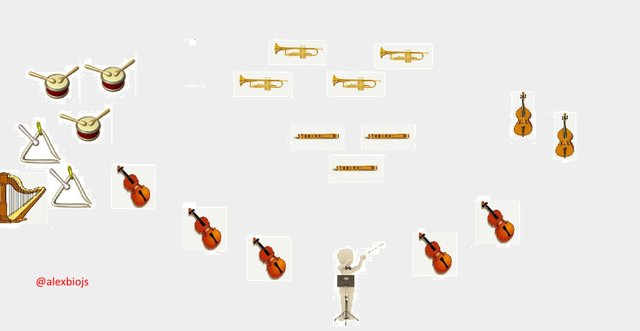
Photoes are from Pixabay (CC0 Creative Commons)(harp, flute, violoncello, violin and conductor), Icon Wanted (CC Attribution 3.0 Unported) (triangle and drum) and Wikipedia (CC BY-SA 3.0) (trumpet)
Evolution
1. Annelida (think of an earthworm) (presumably they appeared near 600-500 million years ago)
These organisms are the first who have a closed circulatory system.
The reason is that unlike their ancestors they have a coelom [2].
Coelom - the principal body cavity in most animals, located between the intestinal canal and the body wall
[4].
So, it wouldn’t be easy to deliver gas to the inner parts of their body without the circulatory system.
Their heart is a complex of ventral and dorsal aortas.
So their circulatory system could be represented like this (you could think of the grey background as the music produced by this orchestra (blood) (well, in this case it’s just a duet yet (flute resembles vessels)))
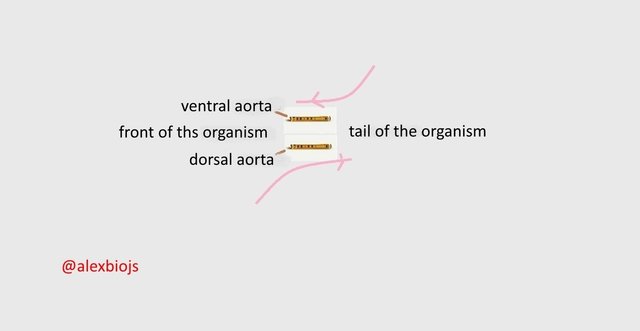
2. Arthropoda (think of a crayfish or any insect)
These organisms have an open circulatory system (which means their blood flows not only through the vessels but it also goes into some parts of their body) which consists of dorsal anterior and posterior vessels and a tubular heart (represented by a percussion instrument – drum) with an intrinsic pacemaker system (it is represented by a conductor) [2].
All of the following groups also have this pacemaker system [3].
Pacemaker system (also known as sinoatrial (SA) node) is a group of special cells which activate other parts of the heart so that it has a correct rhythm
[1].
The blood goes to their heart through a pericardial sinus and goes out of it with the help of anterior and posterior vessels.
So their heart could be illustrated like this
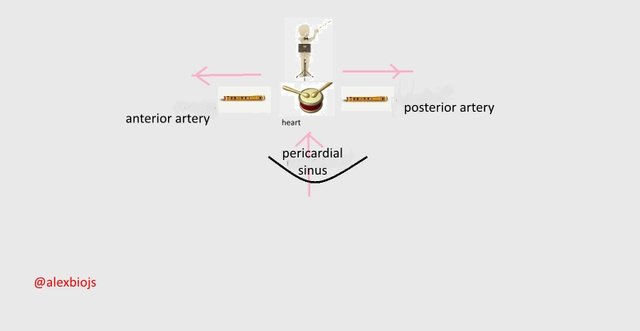
3. Fishes
Their heart is represented by the atrium (represented by a percussion instrument – triangle) and the ventricle (drum). The blood flows through the venous system into it (through the sinus venosus) and then goes into the ventral aorta.
Arteries – those vessels that go out of the heart.
Veins – those vessels that enter the heart.
So the heart of fishes could be represented like this
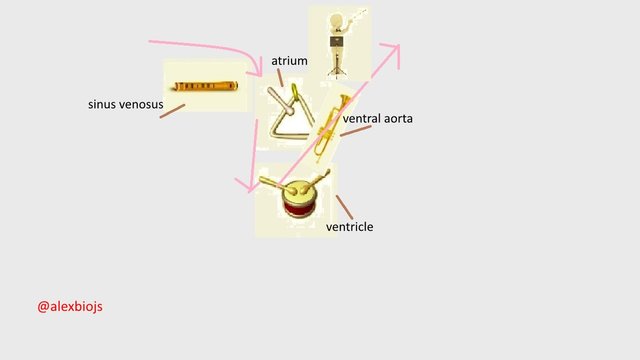
4. Amphibians (think of frogs)
The vertebrate heart develops from four embryological enlargements of a ventral aorta
[2]
The heart of these organisms consists of two atria (which are divided with the septum) and the ventricle. They have lungs. There are two circuits (pulmonary and systemic). Amphibians exchange gas not only with the help of the lungs but also with the skin (so it’s their second respiratory organ). The blood oxygenated with the help of their skin goes into the right atrium and mixes with the blood entering the left atrium from the lungs. The pacemaker system is located in the right atrium (all of the following groups have it in the right atrium as well). So their heart could be illustrated like this
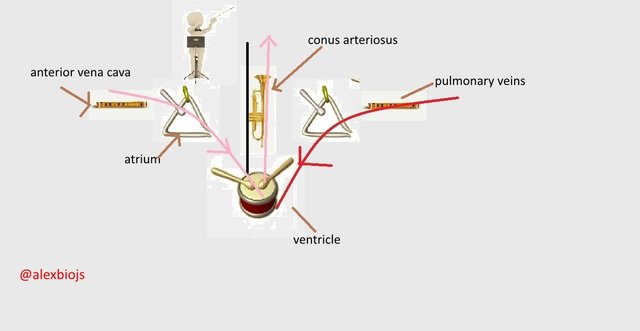
5. Reptiles (think of lizards)
Again, their heart has two completely separated atria and one ventricle (but crocodilians have completely divided ventricles). So the blood again mixes in the ventricle and goes from there into systemic and pulmonary arteries.
Their heart has an atrioventricular valve which prevents the oxygenated and less oxygenated blood from mixing.
So their heart could be represented like this
Where red is oxygenated blood, blue – less oxygenated blood and pink is a mixed blood [2].

6. Birds heart is similar to that of mammals
7. Human
We have two atria and ventricles so our heart could be represented like this

Cardiac cycle
The period of time that begins with contraction of the atria and ends with ventricular relaxation is known as the cardiac cycle
[1]
The period of contraction is called systole.
The period of relaxation is called diastole.
Systole and diastole occur with atria as well as ventricles.
Cardiac cycle of the human heart looks like
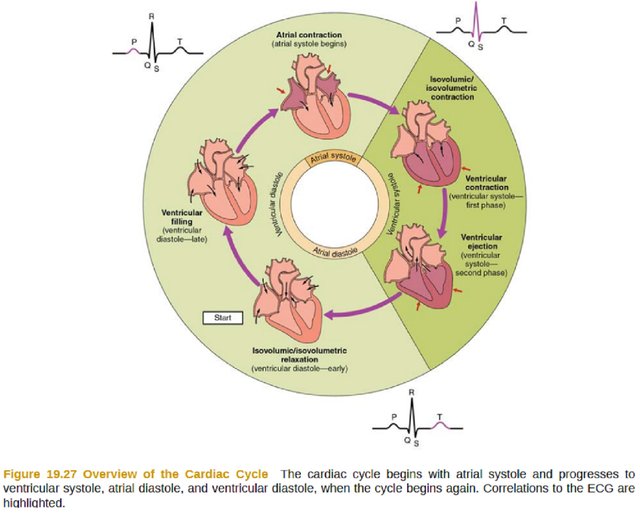
[1] (Creative Commons Attribution 4.0 International License (CC BY 4.0))
ECG is an electrocardiogram (visualization of a human heartbeat).
Well, I've found only data about human heart cardiac cycle.
Atrial systole lasts near 100 ms (P wave of the ECG); Atrial diastole lasts approximately 700 ms;
Ventricular systole lasts near 270 ms (represented by the QRS complex of the ECG on the image above). Ventricular diastole lasts approximately 530 ms (T wave of the ECG) [1].
In the context of this post cardiac cycle could be represented like this (because two parts (ventricles and atria) are playing simultaneously):
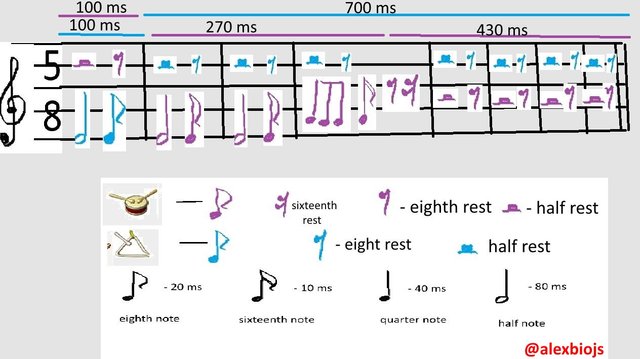
I accept that
the contents of the post, of any kind (own images, videos, parts of text), can be shared by Steemit-Italia and DaVinci staff in the posts related to this initiative.
source
References:
- J. GORDON BETTS, TYLER JUNIOR COLLEGE et al. Anatomy and Physiology, OpenStax, ISBN-10: 1-947172-04-2, 2013.
Creative Commons Attribution 4.0 International License (CC BY 4.0) - Miller−Harley: Zoology, Fifth Edition, ©The McGraw−Hill Companies, 2001
- Silja Burkhard, Vincent van Eif et al. On the Evolution of the Cardiac Pacemaker. J Cardiovasc Dev Dis, 2017.
- Oxford Dictionary of English, 3rd Edition. Oxford University Press, 2010.
I upvoted your post.
Best regards,
@Council
Posted using https://Steeming.com condenser site.
Hi alexbiojs,
Visit curiesteem.com or join the Curie Discord community to learn more.
Wonderful. thanks for sharing
Thanks for your entry in the contest! We are looking forward your entry for WEEK#2 of the contest!
You got our trail vote!
You are right the human anatomy is realy complex and once you listen to those tones and this is in normal anatomy, what about those who have heart murmur sometimes this is systolic or diastolic depending on the problem, some of them could be physiological and due to growth in puberty, just viral infection or some of them due to valve narrowing or prolapsing when the blood flows backward due to leaking valve. In that case the orchestra has more new tones and sometimes even unusual and extraordinary, for those who have very rare defects. So you are right there are many different sounds and tones in our circulatory system :)
Wow , just look at how you represented every living thing discussed in your article and you explained their evolutions in detail. Perfect you.
Posted using Partiko Android
thanks for encouragement and visiting )